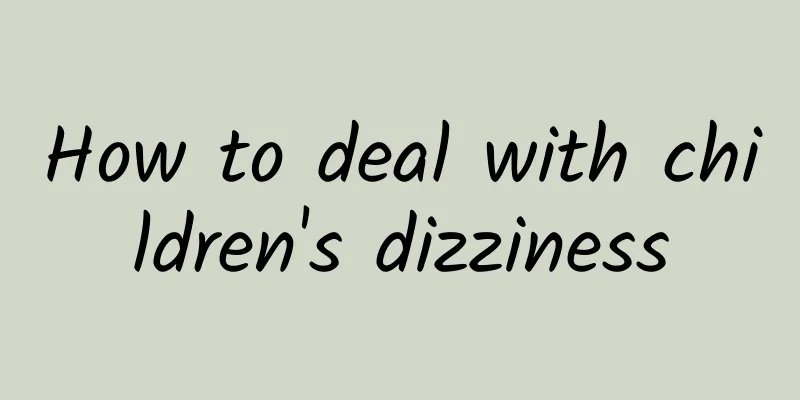How to deal with children's dizziness

|
Have you ever felt dizzy? Do you know why we feel dizzy? One type of dizziness (vertigo) is the illusion of movement or motion hallucination of the surrounding environment caused by spatial positioning disorder. This feeling comes from our vestibular system. Vestibular system The human vestibular system can be divided into three parts: the peripheral vestibular system, the vestibular central system and the motor output system. The peripheral vestibular system is located in our inner ear. The vestibular receptors are composed of the semicircular canals, the utricle and the saccule. The vestibular receptors can sense the rotation of the human head and the linear acceleration movement. After the information is processed by the nerve center, it will be output to the human body: gravity sensing, head orientation perception, control of eyeball rotation and posture control. At the same time, the vestibular center can also process proprioception, vision, hearing, etc. The vestibular center is a more comprehensive sensory center of the human body. Q: What role does the vestibular system play in a child’s development? Answer: Within 15 months after birth, all learning is centered on vestibular development, which is the child's pathway into consciousness. Moreover, important early developments such as balance, autonomous movement, language discrimination, and vision and motor coordination all rely on vestibular sense. Early vestibular development From the fetal period, the vestibular system of children develops very rapidly. It is the first to mature in the human sensory system. From the 10th to 11th week of gestation, the baby begins to move and can feel gravity. At about 5 months of pregnancy, the fetus can feel the mother's body movements. In the neonatal period, as the vestibular system matures further, the baby's posture gradually appears with the age of the month: the development of large movements such as raising the head, stretching, turning over, and sitting up. The function of vestibular sense in childhood In the early days after birth, vestibular sense helps children feel and adapt to changes in gravity, and promotes the development of early primitive reflexes and postural control. The vestibular sense can receive and filter the visual, auditory, olfactory and tactile sensory information directly in front of the head, so that the brain can obtain more appropriate sensory input and reduce the brain's sensory processing pressure. Vestibular sense is the key to maintaining human balance. The human body senses spatial position through vestibular sense and makes movements to maintain body balance. There are three senses involved in human balance: vestibular, proprioceptive and visual. When there is a lack of coordination in the transmission of the three senses, the human body will feel dizzy. At this time, the vestibular sense needs to be adjusted to restore the body's balance. The vestibule is also related to the control of eye movement. Among the eye functions, basic functions such as tracking, maintaining vision, and maintaining attention during movement are closely related to the vestibule. Advanced functions such as attention, reading and learning, and imitation ability are inseparable from the vestibular sense. Vestibular sense is a very important sense for children and plays an indispensable role in their early development. Child caregivers should pay attention to the time of vestibular activities during childhood to promote the development of children's vestibular abilities. Author: Su Hang Unit: Kunming Children's Hospital Reviewer: Liu Yun (Vice Chairman of the Science Popularization Working Committee of the Chinese Rehabilitation Medicine Association, Director of the Rehabilitation Department of Kunming Children's Hospital) This project is funded by the "National Society Science Popularization Capacity Improvement Project-Rehabilitation Science Popularization Service Capacity Improvement Action Plan" |
<<: Can't tell the difference between rhinitis and sinusitis? This is how to easily tell them apart!
>>: Thick legs and short appearance? It may be "false wide hips", these moves can solve the problem!
Recommend
Is body edema a sign of kidney disease? This article will help you understand the truth
Edema is one of the most common clinical manifest...
What items are done during gynecological examinations
When it comes to gynecological examinations, I be...
Picture of bleeding in urine during early pregnancy
Pregnancy is a very lucky thing for women. In the...
20 weeks of pregnancy, fetal movement
As the pregnancy progresses, the baby's fetal...
What is the disease that causes lower abdominal distension, pain and back pain after menstruation?
Women will feel very uncomfortable after menstrua...
Can I drink Pu'er tea during menstruation?
Speaking of Pu'er tea, I believe many people ...
Why can we see more clearly when we squint?
When many children cannot see the blackboard or t...
How many days will it take for the cervical biopsy results to come out?
Many women suffer from cervical diseases, such as...
Should girls learn Korean dance or jazz dance?
Many girls like dancing, but they are always conf...
How to clean scallop meat? How is scallop meat?
Scallops are one of the most popular delicacies. ...
What should girls do if they have stomach pain during menstruation?
We all know that girls will have abdominal pain d...
The more types of additives there are in food, the less safe it is?
Someone asked me: I have seen a strange phenomeno...
Can I drink lemon water during confinement?
Lemonade refers to water soaked with lemons. The ...
Can vaginal wall bleeding cause blood clots?
Vaginal wall prolapse is a relatively common symp...









